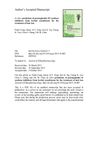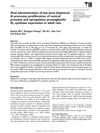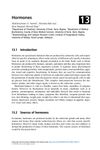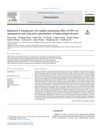TLDR Low-dose bisphenol A increases prostate size in rats by affecting certain enzymes.
The study demonstrated that low-dose bisphenol A (BPA) exposure induced prostate hyperplasia in male Sprague–Dawley rats, with significant effects observed at 30 µg/kg. BPA exposure increased prostate size, glandular secretions, and cell proliferation while decreasing apoptosis, mediated by upregulation of prostaglandin synthases COX-2 and L-PGDS. These enzymes were linked to changes in hormone levels and increased NF-κB p65 expression, suggesting their role in BPA-induced hyperplasia. Inhibitors of COX-2 and L-PGDS reduced these effects, indicating their potential as therapeutic targets. The study involved 50 rats, divided into five groups, and highlighted the need for further research to confirm these findings.
 8 citations
,
February 2019 in “Journal of The European Academy of Dermatology and Venereology”
8 citations
,
February 2019 in “Journal of The European Academy of Dermatology and Venereology”  7 citations
,
October 2017 in “Urologic Oncology: Seminars and Original Investigations”
7 citations
,
October 2017 in “Urologic Oncology: Seminars and Original Investigations” Men with male pattern baldness have a higher risk of aggressive prostate cancer and benign prostatic hyperplasia.
 55 citations
,
July 2016 in “Dermatologic Therapy”
55 citations
,
July 2016 in “Dermatologic Therapy” Multiple treatments work best for hair loss.
 30 citations
,
October 2015 in “Journal of Ethnopharmacology”
30 citations
,
October 2015 in “Journal of Ethnopharmacology” Herbal compounds like ricinoleic acid, quercetin-3-O-rutinoside, and hinokiflavone may be safe and effective for treating hair loss.
 14 citations
,
June 2015 in “Toxicology and Industrial Health”
14 citations
,
June 2015 in “Toxicology and Industrial Health” Low doses of BPA can increase prostate growth and change hormone levels in adult rats.
 14 citations
,
June 2015 in “Toxicology and Industrial Health”
14 citations
,
June 2015 in “Toxicology and Industrial Health” Low doses of BPA can increase prostate growth and change hormone levels in adult rats.
 4 citations
,
January 2018 in “Elsevier eBooks”
4 citations
,
January 2018 in “Elsevier eBooks” Hormones are crucial for regulating body functions and imbalances can lead to health issues.
2 citations
,
March 2021 in “Reproduction” Finasteride may affect male fertility by interfering with specific sperm signaling.
 10 citations
,
December 2017 in “Chemosphere”
10 citations
,
December 2017 in “Chemosphere” Bisphenol-A (BPA) increases connections between brain cells and boosts their activity, but it blocks the effects of a male hormone on brain cell plasticity.
 December 2024 in “Turkish Society of Clinical Biochemistry”
December 2024 in “Turkish Society of Clinical Biochemistry” Higher BPA levels may be linked to idiopathic hyperandrogenemia in women.







